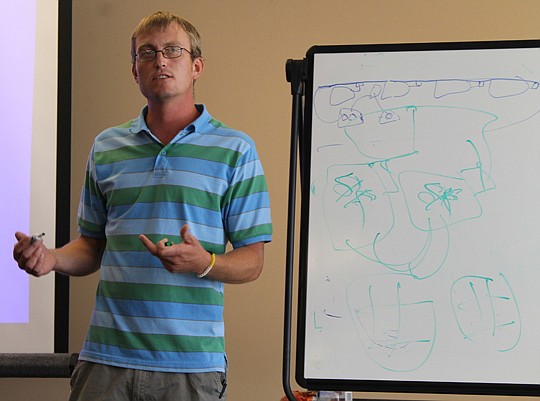
By Carole Hawkins, Staff Writer
Free energy? It’s called the sun.
The sticking point, though, has always been building cost-effective systems to capture it.
At NEFBA’s July E-Council luncheon, Luke Gillim of Jacksonville’s Clear Sky Solar talked about innovations that are making solar-powered homes more practical.
Micro-inverters
The inverter — every solar installation has one. It’s the part of the system that converts the DC current generated by the solar panels into AC current used in the home.
Traditional installations use one expensive central inverter tied to a string of solar panels. That has held back innovation, according to manufacturers of micro-inverters.
With the traditional string design, the connected panels act as if they are one large solar panel. The maximum current output is limited by the worst performing panel in the string, something those in the industry refer to as the “Christmas-lights effect.”
If one panel falls into shade, the whole string’s performance drops.
If one panel malfunctions, the entire string goes down, even when other panels are working.
With a micro-inverter installation, each panel is connected to its own small inverter. All of those mini-electricity generating stations feed into the system’s total output.
That means there is no single point of failure. Also, the output of each micro-inverter can be individually monitored, so installers can easily troubleshoot a problem.
Micro-inverter systems are more scalable, Gillim said. Homeowners can literally add one panel with one micro-inverter as they can afford it.
They also help installers see how well their design performs. Gillim has a micro-inverter system installed on his own home, with one set of panels facing east and another west.
The west-facing panels don’t perform as well because of added resistance created by the afternoon’s heat.
“South is the best,” Gillim said. “But if you have to choose over east and west, put most of your panels on the east.”
Gillim uses Enphase micro-inverters, which have a 25-year warranty.
A 5-kilowatt installation costs about $20,000, he said, and returns that investment within eight to 10 years.
Hybrid systems
When it comes to solar-paneled houses, consumers can choose between off-grid (connected to a bank of batteries) or on-grid (tied to the electric company’s meter).
But Gillim thinks a hybrid system that does both will be the way of the future.
An off-grid system charges batteries that power the house. The drawback is during periods of low sunlight, the power that can be used is limited by the batteries’ storage capacity.
With an on-grid system, solar panels feed power to the utility company through a specially installed meter. The company credits homeowners on their electric bill for the power they generate.
That means the homeowner can have as much energy as they like.
But they can’t control the price they are paid for the energy they generate.
JEA today gives consumers a dollar-for-dollar credit for any electricity sold back, but that policy could change. Now that solar has become so cheap and prevalent, utilities are studying the credits they give to consumers.
Utilities in some western states have switched from paying consumers retail rates to wholesale rates for power they sell back, Gillim said.
A hybrid system uses an inverter/charger to send a portion of the solar power back to the utility company and a portion to a bank of batteries used to power some of the circuits in the house.
During design, Gillim works with the customer to decide which circuits can be pulled off the grid and run on solar.
“It puts you in control of how much of your energy you use and how much you sell back,” Gillim said.
Hybrid systems typically cost 20 to 30 percent more than non-hybrid installations.